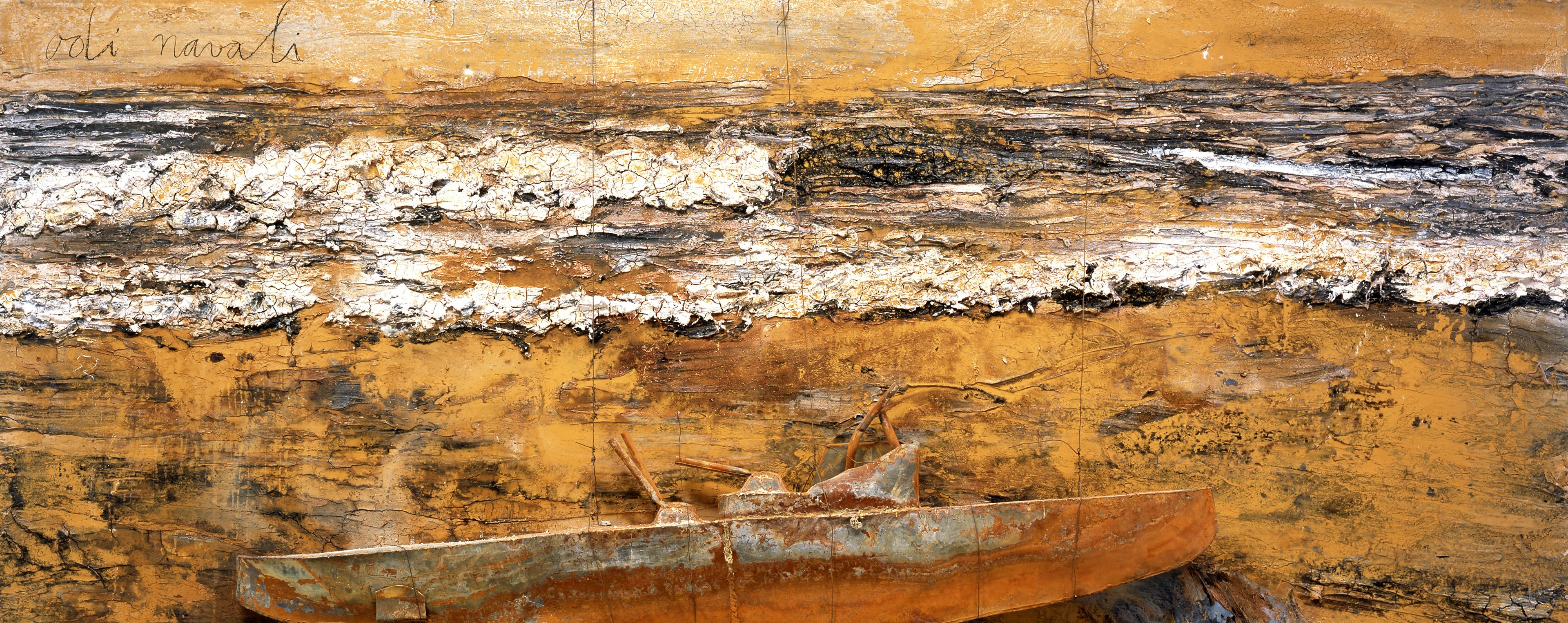 Exhibition
Exhibition- Closed for the season, on view spring 2024
- Building 15
The long-term exhibition—realized in collaboration with the Hall Art Foundation—includes Étroits sont les Vaisseaux (Narrow are the Vessels) (2002), an 82-foot long, undulating wave-like sculpture made of cast concrete, exposed rebar, and lead; The Women of the Revolution (Les Femmes de la Revolution) (1992), comprised of more than twenty lead beds with photographs and wall text; Velimir Chlebnikov (2004), a steel pavilion containing 30 paintings dealing with nautical warfare and inspired by the quixotic theories of the Russian mathematical experimentalist Velimir Chlebnikov; and a new, large-format photograph on lead created by the artist for the installation at MASS MoCA.
 Building 15, photo: Austin Nelson
Building 15, photo: Austin Nelson
Anselm Kiefer, who first visited MASS MoCA in 1990 when the museum was still in the early planning stages, ranks among the best-known and most important of post-World War II German artists living and working today. Born in 1945 in southern Germany during the final days of the collapse of the Third Reich, Kiefer experienced divided postwar Germany firsthand. Across his body of work, Kiefer argues with history, addressing controversial and even taboo issues from recent history with bold directness and lyricism. Kiefer often turns to literature and history as prime source material for his work, as he did, for example, in the suite of paintings that comprise Velimir Chlebnikov (2004).
 Anselm Kiefer, The Women of the Revolution (Les Femmes de la Révolution), 1992/2013 (detail)
Anselm Kiefer, The Women of the Revolution (Les Femmes de la Révolution), 1992/2013 (detail)
Lead beds: dimensions variable, Photograph on lead: 138 x 174 inches (350 x 442 cm)
Photo: Arthur Evans, courtesy of the Hall Art Foundation, © Anselm Kiefer
The artist often builds his imagery on top of photographs, layering his massive canvases with dirt, lead, straw, and other materials that generate a “ground” that reads literally of the earth itself. Within these thick, impastoed surfaces Kiefer embeds textual or symbolic references to historic figures or places; these become encoded signals through which Kiefer invokes and processes history.
 Anselm Kiefer, Velimir Chlebnikov, 2004 (detail)
Anselm Kiefer, Velimir Chlebnikov, 2004 (detail)
30 paintings: oil, emulsion, acrylic, lead and mixed media on canvas, 18 paintings: 75 x 130 inches (190.5 x 330 cm) each, 12 paintings: 75 x 110 inches (190.5 x 280 cm) each, Hall Collection
Photo: Arthur Evans, courtesy of the Hall Art Foundation, © Anselm Kiefer
A law student, Kiefer switched his studies to art in 1965 and held his first solo exhibit in 1969. During the early 1970s he studied with conceptual artist Joseph Beuys, whose interest in using an array of cultural myths, metaphors, and personal symbolic vocabulary as a means to engage and understand history inspired Kiefer. The artist has described his own art-making process as stimulated by Beuys’ philosophies: “Painting, for me, is not just about creating an illusion. I don’t paint to present an image of something. I paint only when I have received an apparition, a shock, when I want to transform something. Something that possesses me, and from which I have to deliver myself. Something I need to transform, to metabolize, and which gives me a reason to paint.” Like Beuys, whose works were often constructed of fragile, organic materials (including blood, fat, and honey), Kiefer’s works often incorporate unusual, fugitive materials such as ash, clay, and dried plant materials. With their rough-hewn textures and expansive narrative formats that often evoke charred landscape and historical, sometimes apocalyptic settings, Kiefer’s work did not conform to the pared-down Minimalist or Conceptualist movements that were becoming mainstream at the time he was a student. Instead he created massive, dark paintings, books constructed of large sheets of lead, and figurative works that explored German folklore and were inspired by Caspar David Friedrich, among others.
 Anselm Kiefer, Velimir Chlebnikov, 2004 (detail)
Anselm Kiefer, Velimir Chlebnikov, 2004 (detail)
30 paintings: oil, emulsion, acrylic, lead and mixed media on canvas, 18 paintings: 75 x 130 inches (190.5 x 330 cm) each, 12 paintings: 75 x 110 inches (190.5 x 280 cm) each, Hall Collection
Photo: Arthur Evans, courtesy of the Hall Art Foundation, © Anselm Kiefer
Further Reading
Sebastian Smee, “Kiefer conjures history, irony, and myth,” The Boston Globe (2014)
The Hall Art Foundation makes available works of postwar and contemporary art from its collection and from the collection of Andrew and Christine Hall for the enjoyment and education of the public. In addition to the dedicated gallery space at MASS MoCA, the Hall Art Foundation operates a contemporary art space in Reading, Vermont. Read more here about the Kiefer exhibition.


